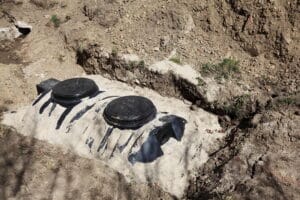How an Aerobic Septic System Works
 Understanding your septic system is essential for maintaining its performance and ensuring the longevity of your wastewater management. One of the most efficient systems available today is the aerobic septic system. So here, we will explain how aerobic septic systems work, their benefits, and why they might be the right choice for your property.
Understanding your septic system is essential for maintaining its performance and ensuring the longevity of your wastewater management. One of the most efficient systems available today is the aerobic septic system. So here, we will explain how aerobic septic systems work, their benefits, and why they might be the right choice for your property.
What is an Aerobic Septic System?
An aerobic septic system is a type of wastewater treatment system that utilizes aerobic bacteria to break down organic matter. Unlike traditional anaerobic septic systems, which rely on bacteria that thrive in environments devoid of oxygen, aerobic systems introduce air into the treatment process. This oxygen-rich environment promotes the growth of aerobic bacteria, which are more efficient at decomposing waste.
The Key Components
An aerobic septic system typically consists of several key components:
- Septic Tank: The initial holding tank where solids settle at the bottom, and liquid waste flows to the next stage.
- Aeration Chamber: This chamber is where air is introduced. A mechanical aerator pumps air into the wastewater, enriching it with oxygen and creating an ideal environment for aerobic bacteria.
- Treatment Chamber: Here, the aerobic bacteria break down organic matter, converting it into harmless byproducts such as carbon dioxide, water, and biomass.
- Disinfection Unit: In some systems, a disinfection unit may be included to further treat the effluent before it is released into the drainage field or other disposal areas.
- Drain Field: After treatment, the effluent is discharged into a drain field where it undergoes additional natural filtration through soil layers.
How an Aerobic Septic System Works: The Process
- Wastewater Collection: Wastewater from your home flows into the septic tank where heavier solids settle at the bottom, forming sludge, while lighter materials, such as grease, float to the top, forming scum.
- Aeration: After the initial settling period, the liquid effluent is pumped into the aeration chamber. Here, the mechanical aerator infuses air into the wastewater, promoting the growth of aerobic bacteria.
- Biological Treatment: In the aeration chamber, the aerobic bacteria consume the organic matter in the wastewater, breaking it down efficiently. This process significantly reduces the volume of sludge and scum, resulting in cleaner effluent.
- Clarification: The treated effluent then flows into a settling tank or clarification chamber, where any remaining solids are allowed to settle out of the liquid.
- Disinfection: If equipped, the effluent may pass through a disinfection unit where it is treated with chlorine, UV light, or ozone, eliminating any remaining pathogens before it is discharged into the drain field.
- Final Disposal: The treated effluent is then released into the drain field, where it undergoes final filtration through soil, further purifying it before it re-enters the groundwater system.
The Benefits of These Types of Systems
- Efficiency: Aerobic systems can treat wastewater more thoroughly than anaerobic systems, resulting in cleaner effluent and reducing the risk of groundwater contamination.
- Space-Saving: Aerobic septic systems typically require less space than traditional septic systems, making them ideal for smaller lots or sites with challenging terrain.
- Reduced Maintenance: While aerobic systems do require regular maintenance, including inspections and aerator service, they often have fewer issues with solids buildup compared to traditional systems.
- Higher Treatment Levels: These systems can provide a higher level of treatment, making them suitable for areas with strict environmental regulations.
Is an Aerobic Septic System Right for You?
Aerobic septic systems provide an advanced, efficient, and environmentally friendly solution for wastewater treatment. By introducing oxygen into the process, they ensure cleaner effluent. This reduces risk of groundwater contamination, and ensures suitability for properties with space or soil limitations. While they do require regular maintenance, the long-term benefits often outweigh the upkeep. Whether you’re building a new home, upgrading an outdated system, or exploring ways to better protect your property and the environment, an aerobic septic system may be the right choice. Consult with professionals like Red Dirt Septic to ensure your system is designed, installed, and maintained for optimal performance.
Need a New Septic System Installed?
Call us today for more information and to set up an onsite evaluation.
Septic System Installation
 Understanding your septic system is essential for maintaining its performance and ensuring the longevity of your wastewater management. One of the most efficient systems available today is the aerobic septic system. So here, we will explain how aerobic septic systems work, their benefits, and why they might be the right choice for your property.
Understanding your septic system is essential for maintaining its performance and ensuring the longevity of your wastewater management. One of the most efficient systems available today is the aerobic septic system. So here, we will explain how aerobic septic systems work, their benefits, and why they might be the right choice for your property.